Analysis and Prediction of Ecosystem Service Values Based on Land Use/Cover Change in the Yiluo River Basin
Abstract
:1. Introduction
2. Materials and Methods
2.1. Study Area
2.2. Data
2.3. Detecting Land Use/Cover Change
- (1)
- Dynamic degree change
- (2)
- Land use/cover conversion matrix
2.4. Ecosystem Service Valuation
2.5. FLUS Model Simulation and Validation
3. Results
3.1. Land Use/Cover Change during 2000–2020
3.1.1. Temporal Analysis of Land Use/Cover Change
3.1.2. Transformation Patterns of Land Use/Cover Types
3.2. Changes in Ecosystem Service Values during 2000–2020
3.2.1. Changes in Ecosystem Service Values of Different Land Use/Cover Type
3.2.2. Changes in Different Ecosystem Service Values
3.3. Future Changes in Land Use/Cover and Ecosystem Service Values under Different RCPs Scenarios
3.3.1. Future Changes in Land Use/Cover under Different RCPs Scenarios
3.3.2. Future Changes in Ecosystem Service Values under Different RCPs Scenarios
4. Discussion
5. Conclusions
- (1)
- In the past 20 years, the land use/cover, affected by climate change and human activities, in the Yiluo River basin has undergone great changes, which mainly showed that the area of cultivated land had the most loss, the area of construction land increased the most, and water bodies and unutilized land had the highest dynamic degree.
- (2)
- From 2000 to 2020, the total ESVs increased by 459 million dollars, which attributed to the increase of forestland and water bodies in recent years. Among them, water bodies increased the most, with an increase of 565 million dollars.
- (3)
- By 2030, the total ESVs continued to present an upward trend compared with 2020, which increase by 12 million dollars, 31 million dollars, and 29 million dollars, respectively under the scenario of RCP2.6, RCP4.5, and RCP8.5, and this discrepancy in different scenarios was mainly reflected in forestland and water bodies.
- (4)
- This research will contribute to understanding the land use/cover change effects on ecosystem services for decision-makers and provide a relevant scientific reference and support for ecosystem protection and integrated management in the Yiluo River Basin.
Author Contributions
Funding
Institutional Review Board Statement
Informed Consent Statement
Data Availability Statement
Acknowledgments
Conflicts of Interest
References
- Foley, J.A.; Defries, R.; Asner, G.P.; Barford, C.; Bonan, G.; Carpenter, S.R.; Chapin, F.S.; Coe, M.T.; Daily, G.C.; Gibbs, H.K.; et al. Global consequences of land use. Science 2005, 309, 570–574. [Google Scholar] [CrossRef] [Green Version]
- Veldkamp, A.; Lambinb, E. Predicting land-use change. Agriculture, Ecosyst. Environ. 2001, 85, 1–6. [Google Scholar] [CrossRef]
- Lambin, E.F.; Meyfroidt, P. Global land use change, economic globalization, and the looming land scarcity. Proc. Natl. Acad. Sci. USA 2011, 108, 3465–3472. [Google Scholar] [CrossRef] [PubMed] [Green Version]
- Lambin, E.F.; Turner, B.L.; Geist, H.J.; Agbola, S.B.; Angelsen, A.; Bruce, J.W.; Coomes, O.T.; Dirzo, R.; Fischer, G.; Folke, C.; et al. The causes of land-use and land-cover change: Moving beyond the myths. Glob. Environ. Chang. 2001, 11, 261–269. [Google Scholar] [CrossRef]
- Bohn, T.J.; Vivoni, E.R.; Mascaro, G.; White, D.D. Land and water use changes in the US-Mexico border region, 1992–2011. Environ. Res. Lett. 2018, 13, 114005. [Google Scholar] [CrossRef] [Green Version]
- Kalantari, Z.; Santos Ferreira, C.S.; Page, J.; Goldenberg, R.; Olsson, J.; Destouni, G. Meeting sustainable development challenges in growing cities: Coupled social-ecological systems modeling of land use and water changes. J. Environ. Manag. 2019, 245, 471–480. [Google Scholar] [CrossRef] [PubMed]
- Feng, Z.D. Hydrological and ecological responses to climatic change and to land-use/land-cover changes in Central Asia. Quat. Int. 2013, 311, 1–2. [Google Scholar] [CrossRef]
- Wang, Q.; Xu, Y.; Wang, Y.; Zhang, Y.; Xiang, J.; Xu, Y.; Wang, J. Individual and combined impacts of future land-use and climate conditions on extreme hydrological events in a representative basin of the Yangtze River Delta, China. Atmos. Res. 2020, 236, 104805. [Google Scholar] [CrossRef]
- Huang, C.; Zhang, M.; Zou, J.; Zhu, A.; Chen, X.; Mi, Y.; Wang, Y.; Yang, H.; Li, Y. Changes in land use, climate and the environment during a period of rapid economic development in Jiangsu Province, China. Sci. Total Environ. 2015, 536, 173–181. [Google Scholar] [CrossRef]
- Watson, L.; Straatsma, M.W.; Wanders, N.; Verstegen, J.A.; de Jong, S.M.; Karssenberg, D. Global ecosystem service values in climate class transitions. Environ. Res. Lett. 2020, 15, 24008. [Google Scholar] [CrossRef]
- Fang, S.; Yan, J.; Che, M.; Zhu, Y.; Liu, Z.; Pei, H.; Zhang, H.; Xu, G.; Lin, X. Climate change and the ecological responses in Xinjiang, China: Model simulations and data analyses. Quat. Int. 2013, 311, 108–116. [Google Scholar] [CrossRef]
- Song, W.; Deng, X. Land-use/land-cover change and ecosystem service provision in China. Sci. Total Environ. 2017, 576, 705–719. [Google Scholar] [CrossRef] [PubMed]
- Xie, G.; Zhang, C.; Zhen, L.; Zhang, L. Dynamic changes in the value of China’s ecosystem services. Ecosyst. Serv. 2017, 26, 146–154. [Google Scholar] [CrossRef]
- Wang, Y.; Dai, E.; Yin, L.; Ma, L. Land use/land cover change and the effects on ecosystem services in the Hengduan Mountain region, China. Ecosyst. Serv. 2018, 34, 55–67. [Google Scholar] [CrossRef]
- Allan, J.D. Landscapes and Riverscapes: The Influence of Land Use on Stream Ecosystems. Annu. Rev. Ecol. Evol. Syst. 2004, 35, 257–284. [Google Scholar] [CrossRef] [Green Version]
- Costanza, R.; D’Arge, R.; De Groot, R.; Farber, S.; Grasso, M.; Hannon, B.; Limburg, K.; Naeem, S.; O’neill, R.V.; Paruelo, J. The value of the world’s ecosystem services and natural capital. Nature 1997, 387, 253–260. [Google Scholar] [CrossRef]
- Raymond, C.M.; Bryan, B.A.; MacDonald, D.H.; Cast, A.; Strathearn, S.; Grandgirard, A.; Kalivas, T. Mapping community values for natural capital and ecosystem services. Ecol. Econ. 2009, 68, 1301–1315. [Google Scholar] [CrossRef]
- Kreuter, U.P.; Harris, H.G.; Matlock, M.D.; Lacey, R.E. Change in ecosystem service values in the San Antonio area, Texas. Ecol. Econ. 2001, 39, 333–346. [Google Scholar] [CrossRef]
- Rai, R.; Zhang, Y.; Paudel, B.; Acharya, B.; Basnet, L. Land Use and Land Cover Dynamics and Assessing the Ecosystem Service Values in the Trans-Boundary Gandaki River Basin, Central Himalayas. Sustainability 2018, 10, 3052. [Google Scholar] [CrossRef] [Green Version]
- Msofe, N.K.; Sheng, L.; Li, Z.; Lyimo, J. Impact of Land Use/Cover Change on Ecosystem Service Values in the Kilombero Valley Floodplain, Southeastern Tanzania. Forests 2020, 11, 109. [Google Scholar] [CrossRef] [Green Version]
- Gedefaw, A.; Atzberger, C.; Bauer, T.; Agegnehu, S.; Mansberger, R. Analysis of Land Cover Change Detection in Gozamin District, Ethiopia: From Remote Sensing and DPSIR Perspectives. Sustainability 2020, 12, 4534. [Google Scholar] [CrossRef]
- Xie, G.D.; Zhen, L.; Lu, C.X.; Xiao, Y.; Chen, C. Expert Knowledge Based Valuation Method of Ecosystem Services in China. J. Nat. Resour. 2008, 23, 911–919. [Google Scholar]
- Costanza, R.; De Groot, R.; Sutton, P.; Van Der Ploeg, S.; Anderson, S.J.; Kubiszewski, I.; Farber, S.; Turner, R.K. Changes in the global value of ecosystem services. Glob. Environ. Chang. 2014, 26, 152–158. [Google Scholar] [CrossRef]
- Riao, D.; Zhu, X.; Tong, Z.; Zhang, J.; Wang, A. Study on Land Use/Cover Change and Ecosystem Services in Harbin, China. Sustainability 2020, 12, 6076. [Google Scholar] [CrossRef]
- Mortoja, M.G.; Yigitcanlar, T. Local Drivers of Anthropogenic Climate Change: Quantifying the Impact through a Remote Sensing Approach in Brisbane. Remote Sens. 2020, 12, 2270. [Google Scholar] [CrossRef]
- Hu, Z.; Wang, S.; Bai, X.; Luo, G.; Li, Q.; Wu, L.; Yang, Y.; Tian, S.; Li, C.; Deng, Y. Changes in ecosystem service values in karst areas of China. Agric. Ecosyst. Environ. 2020, 301, 107026. [Google Scholar] [CrossRef]
- Woldeyohannes, A.; Cotter, M.; Biru, W.; Kelboro, G. Assessing Changes in Ecosystem Service Values over 1985–2050 in Response to Land Use and Land Cover Dynamics in Abaya-Chamo Basin, Southern Ethiopia. Land 2020, 9, 37. [Google Scholar] [CrossRef] [Green Version]
- Ma, X.; Zhu, J.; Zhang, H.; Yan, W.; Zhao, C. Trade-offs and synergies in ecosystem service values of inland lake wetlands in Central Asia under land use/cover change: A case study on Ebinur Lake, China. Glob. Ecol. Conserv. 2020, 24, e1253. [Google Scholar] [CrossRef]
- Jiang, W.; Lü, Y.; Liu, Y.; Gao, W. Ecosystem service value of the Qinghai-Tibet Plateau significantly increased during 25 years. Ecosyst. Serv. 2020, 44, 101146. [Google Scholar] [CrossRef]
- Talukdar, S.; Singha, P.; Mahato, S.; Praveen, B.; Rahman, A. Dynamics of ecosystem services (ESs) in response to land use land cover (LU/LC) changes in the lower Gangetic plain of India. Ecol. Indic. 2020, 112, 106121. [Google Scholar] [CrossRef]
- Ligate, E.J.; Chen, C.; Wu, C. Evaluation of tropical coastal land cover and land use changes and their impacts on ecosystem service values. Ecosyst. Health Sustain. 2018, 4, 188–204. [Google Scholar] [CrossRef] [Green Version]
- Schirpke, U.; Tscholl, S.; Tasser, E. Spatio-temporal changes in ecosystem service values: Effects of land-use changes from past to future (1860–2100). J. Environ. Manag. 2020, 272, 111068. [Google Scholar] [CrossRef] [PubMed]
- Liu, Y.; Hou, X.; Li, X.; Song, B.; Wang, C. Assessing and predicting changes in ecosystem service values based on land use/cover change in the Bohai Rim coastal zone. Ecol. Indic. 2020, 111, 106004. [Google Scholar] [CrossRef]
- Wu, C.; Chen, B.; Huang, X.; Dennis Wei, Y.H. Effect of land-use change and optimization on the ecosystem service values of Jiangsu province, China. Ecol. Indic. 2020, 117, 106507. [Google Scholar] [CrossRef]
- Yirsaw, E.; Wu, W.; Shi, X.; Temesgen, H.; Bekele, B. Land Use/Land Cover Change Modeling and the Prediction of Subsequent Changes in Ecosystem Service Values in a Coastal Area of China, the Su-Xi-Chang Region. Sustainability 2017, 9, 1204. [Google Scholar] [CrossRef] [Green Version]
- Liu, Q.; Yang, Z.; Cui, B.; Sun, T. Temporal trends of hydro-climatic variables and runoff response to climatic variability and vegetation changes in the Yiluo River basin, China. Hydrol. Process. 2009, 23, 3030–3039. [Google Scholar] [CrossRef]
- Wang, X.; Zhang, P.; Liu, L.; Li, D.; Wang, Y. Effects of Human Activities on Hydrological Components in the Yiluo River Basin in Middle Yellow River. Water 2019, 11, 689. [Google Scholar] [CrossRef] [Green Version]
- Gu, W.; Chen, B.; Yang, Y.; Dong, G. Simulation evaluation and uncertainty analysis for climate change projections in East China made by IPCC-AR4 models. Prog. Geogr. 2010, 29, 818–826. [Google Scholar]
- Zhang, S.; Gu, Y.; Lin, J. Uncertainty analysis in the application of climate models. Adv. Water Sci. 2010, 21, 504–511. [Google Scholar]
- Yuan, S.; Zhu, C.; Yang, L.; Xie, F. Responses of Ecosystem Services to Urbanization-Induced Land Use Changes in Ecologically Sensitive Suburban Areas in Hangzhou, China. Int. J. Environ. Res. Public Health 2019, 16, 1124. [Google Scholar] [CrossRef] [Green Version]
- Liu, X.; Liang, X.; Li, X.; Xu, X.; Ou, J.; Chen, Y.; Li, S.; Wang, S.; Pei, F. A future land use simulation model (FLUS) for simulating multiple land use scenarios by coupling human and natural effects. Landsc. Urban. Plan. 2017, 168, 94–116. [Google Scholar] [CrossRef]
- Liang, X.; Liu, X.; Li, X.; Chen, Y.; Tian, H.; Yao, Y. Delineating multi-scenario urban growth boundaries with a CA-based FLUS model and morphological method. Landsc. Urban. Plan. 2018, 177, 47–63. [Google Scholar] [CrossRef]
- Liang, X.; Liu, X.; Li, D.; Zhao, H.; Chen, G. Urban growth simulation by incorporating planning policies into a CA-based future land-use simulation model. Int. J. Geogr. Inf. Sci. IJGIS 2018, 32, 2294–2316. [Google Scholar] [CrossRef]
- Wang, J.; Wang, K.; Qin, T.; Nie, H.; Lv, Z.; Liu, F.; Shi, X.; Hu, Y. Analysis and prediction of LUCC change in Huang-Huai-Hai river basin. Open Geosci 2020, 12, 1406–1420. [Google Scholar] [CrossRef]
- Foley, J.A.; Ramankutty, N.; Brauman, K.A.; Cassidy, E.S.; Gerber, J.S.; Johnston, M.; Mueller, N.D.; O’Connell, C.; Ray, D.K.; West, P.C.; et al. Solutions for a cultivated planet. Nature 2011, 478, 337–342. [Google Scholar] [CrossRef] [PubMed] [Green Version]
- Chen, J.; Yin, S.; Gebhardt, H.; Yang, X. Farmers’ livelihood adaptation to environmental change in an arid region: A case study of the Minqin Oasis, northwestern China. Ecol. Indic. 2018, 93, 411–423. [Google Scholar] [CrossRef]
- Jiang, W.; Fu, B.; Lü, Y. Assessing Impacts of Land Use/Land Cover Conversion on Changes in Ecosystem Services Value on the Loess Plateau, China. Sustainability 2020, 12, 7128. [Google Scholar] [CrossRef]
- Zhang, F.; Yushanjiang, A.; Jing, Y. Assessing and predicting changes of the ecosystem service values based on land use/cover change in Ebinur Lake Wetland National Nature Reserve, Xinjiang, China. Sci. Total Environ. 2019, 656, 1133–1144. [Google Scholar] [CrossRef] [PubMed]
- Sun, Y.; Liu, S.; Dong, Y.; Dong, S.; Shi, F. Effects of multi-time scales drought on vegetation dynamics in Qaidam River Basin, Qinghai-Tibet Plateau from 1998 to 2015. Appl. Clim. 2020, 141, 117–131. [Google Scholar] [CrossRef]
- Saiz, G.; Bird, M.I.; Domingues, T.; Schrodt, F.; Schwarz, M.; Feldpausch, T.R.; Veenendaal, E.; Djagbletey, G.; Hien, F.; Compaore, H.; et al. Variation in soil carbon stocks and their determinants across a precipitation gradient in West Africa. Glob. Chang. Biol. 2012, 18, 1670–1683. [Google Scholar] [CrossRef]
- Souza, R.; Feng, X.; Antonino, A.; Montenegro, S.; Souza, E.; Porporato, A. Vegetation response to rainfall seasonality and interannual variability in tropical dry forests. Hydrol. Process. 2016, 30, 3583–3595. [Google Scholar] [CrossRef]
- Xu, Z.X.; Li, J.Y.; Liu, C.M. Long-term trend analysis for major climate variables in the Yellow River basin*. Hydrol. Process. 2007, 21, 1935–1948. [Google Scholar] [CrossRef]
- Liu, L.; Xu, H.; Wang, Y.; Jiang, T. Impacts of 1.5 and 2 °C global warming on water availability and extreme hydrological events in Yiluo and Beijiang River catchments in China. Clim. Chang. 2017, 145, 145–158. [Google Scholar] [CrossRef] [Green Version]
- Jung, S.H.; Feng, T. Government subsidies for green technology development under uncertainty. Eur. J. Oper. Res. 2020, 286, 726–739. [Google Scholar] [CrossRef]


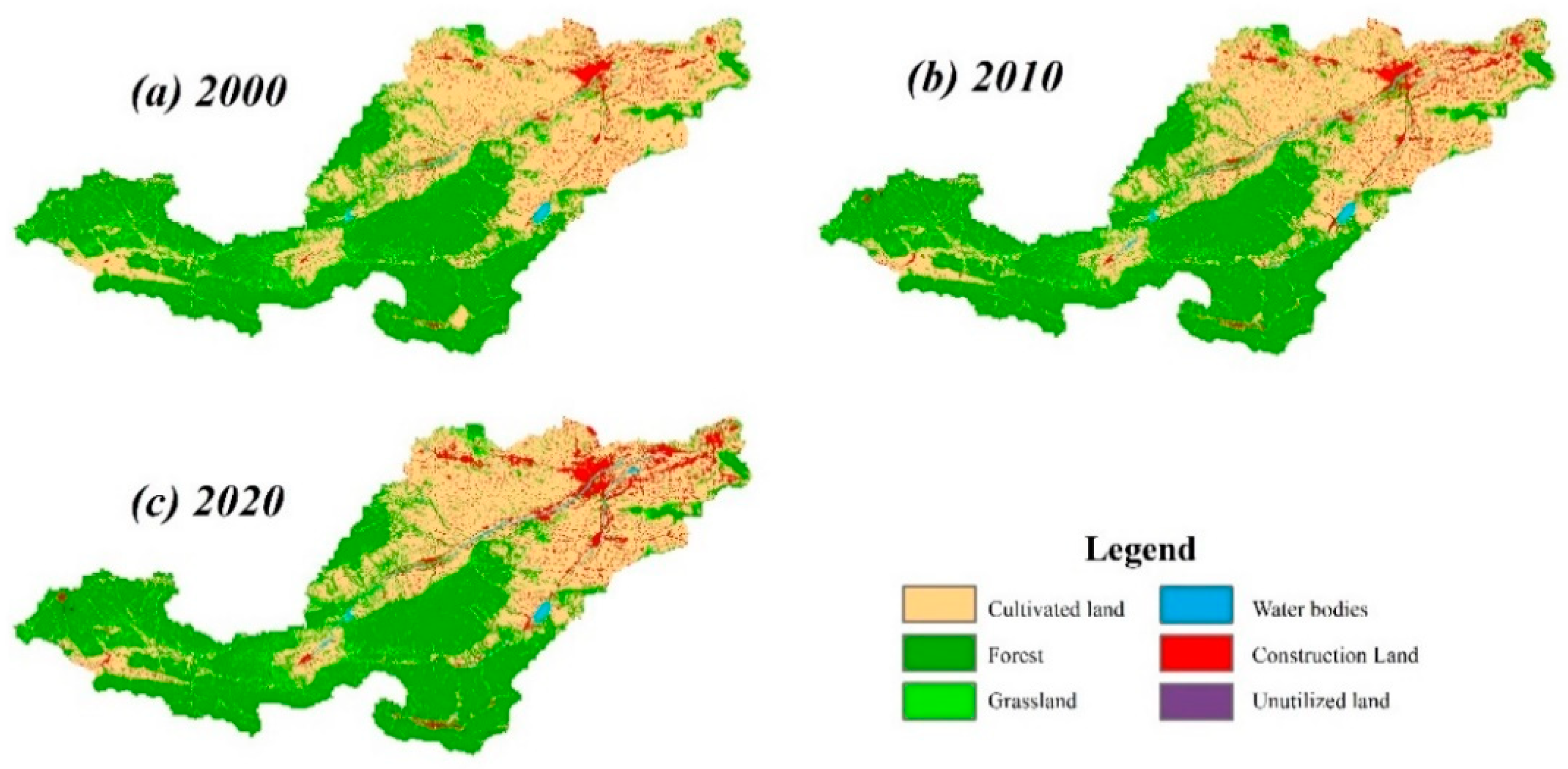
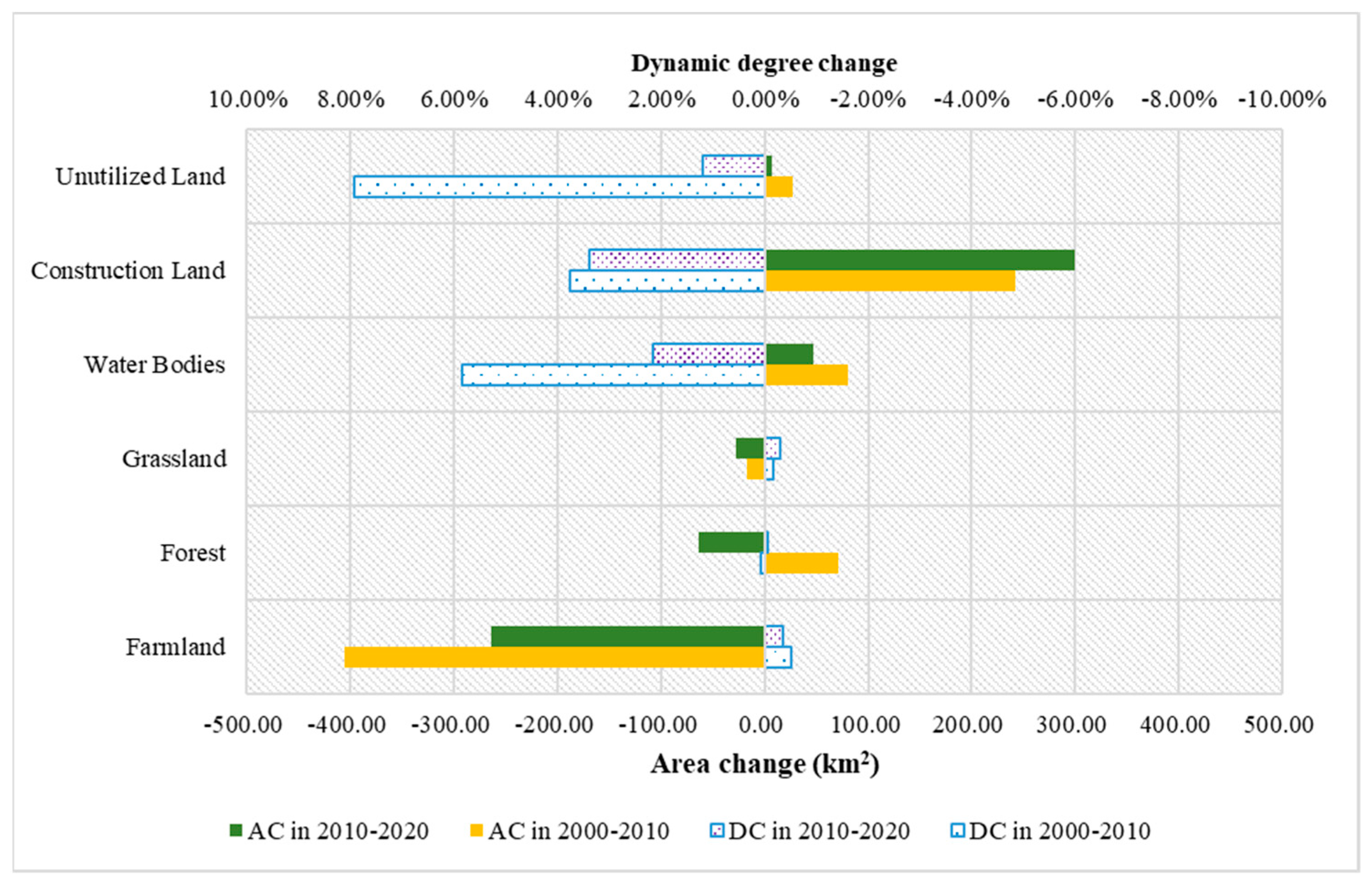

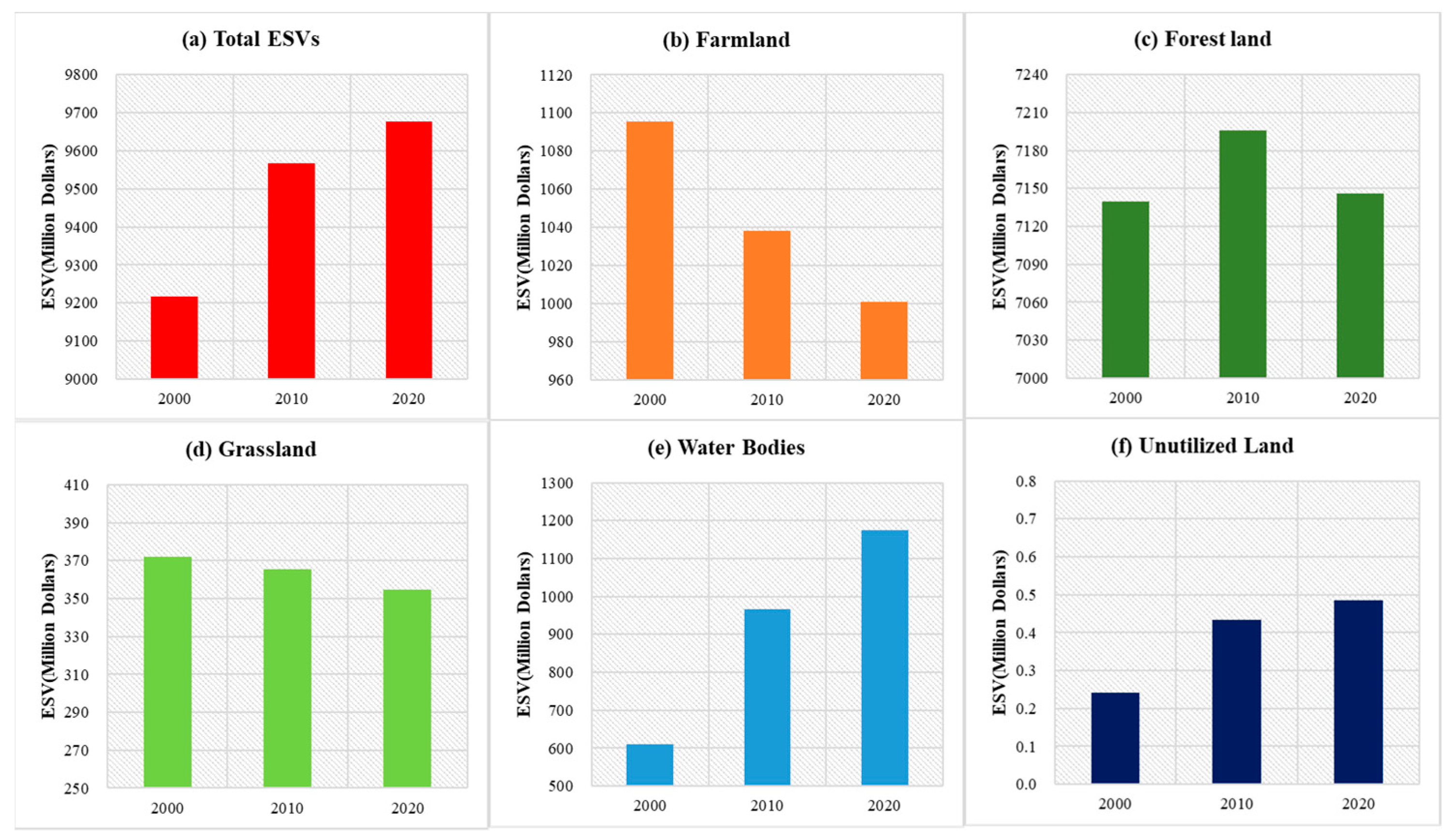
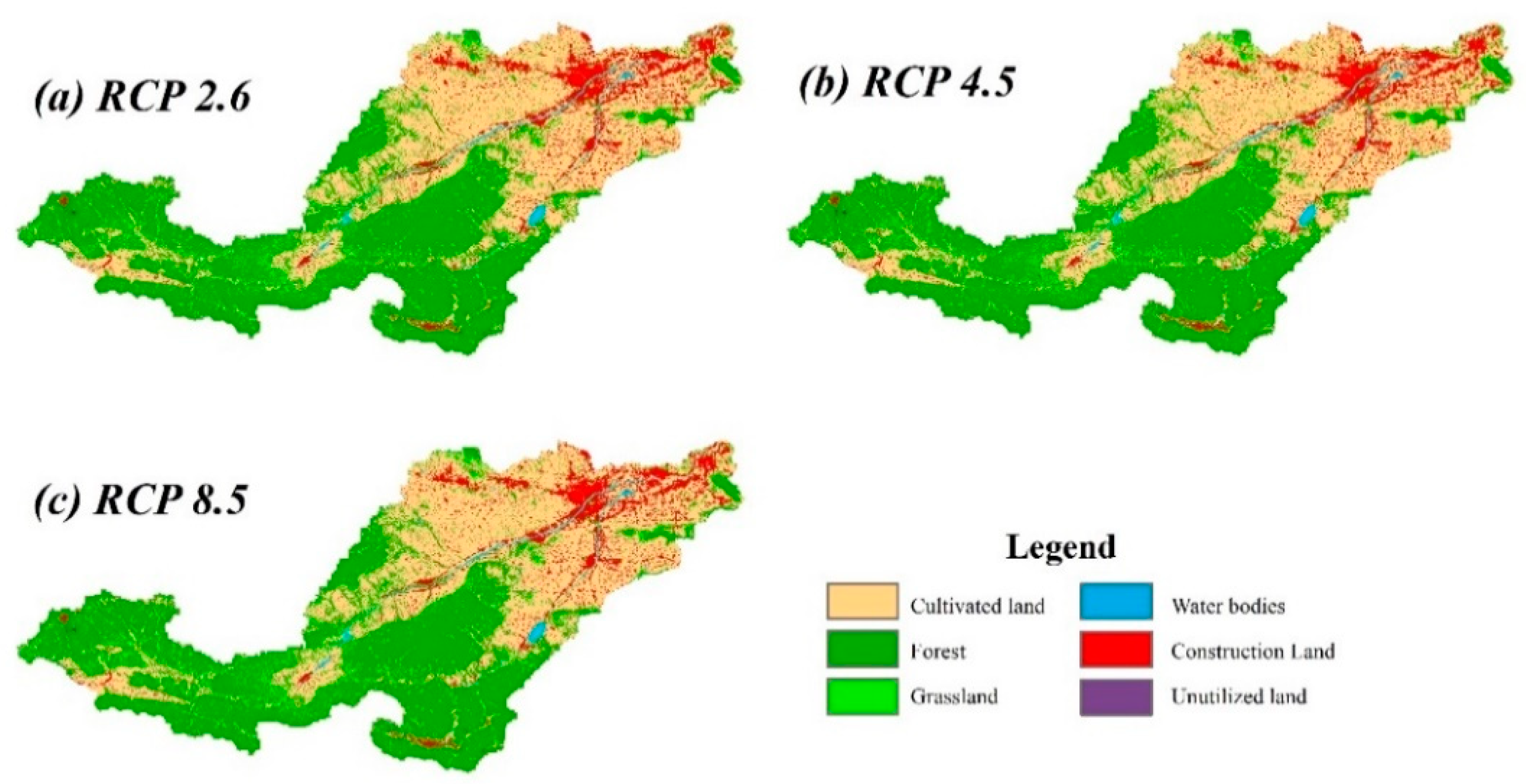
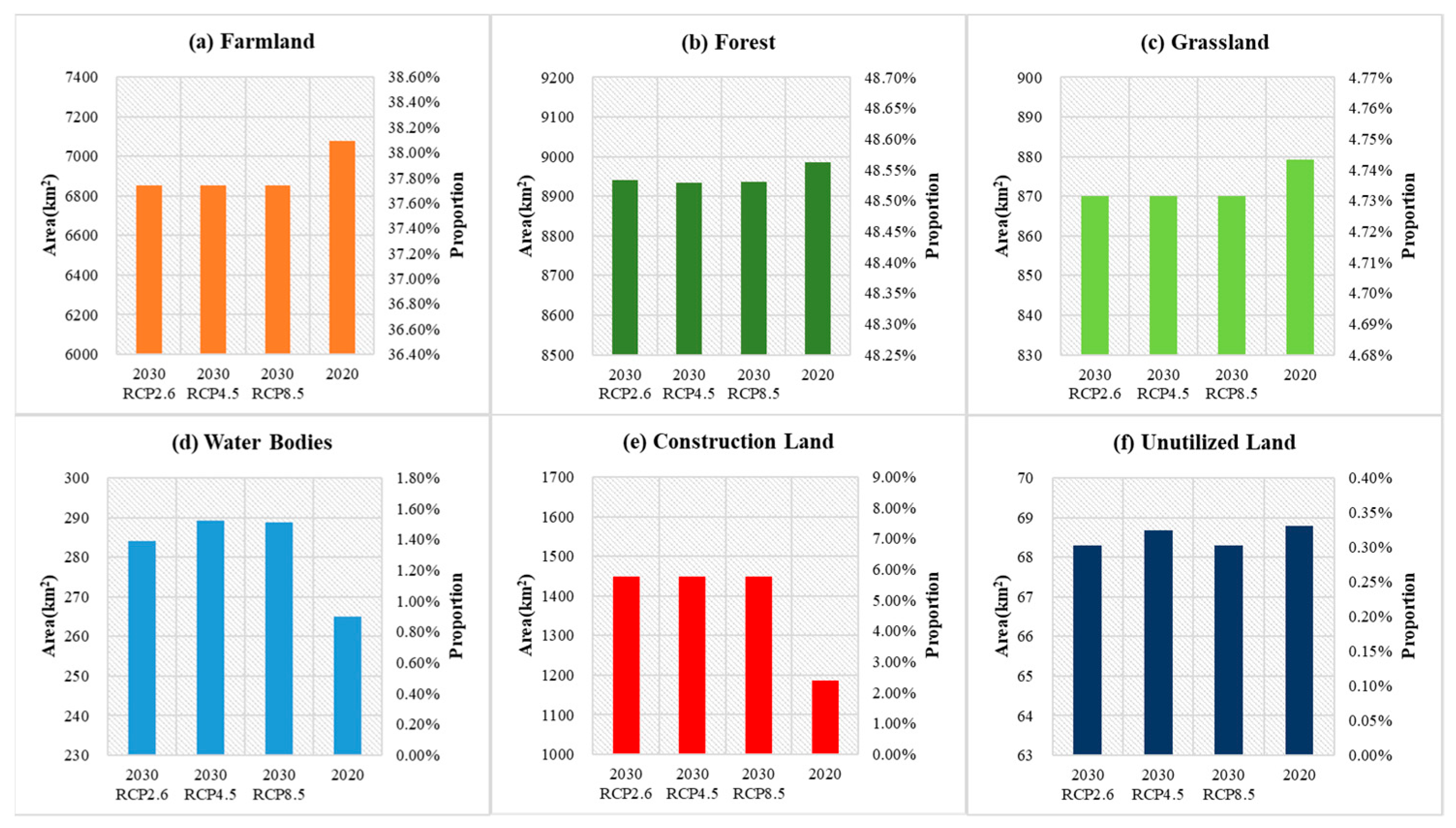
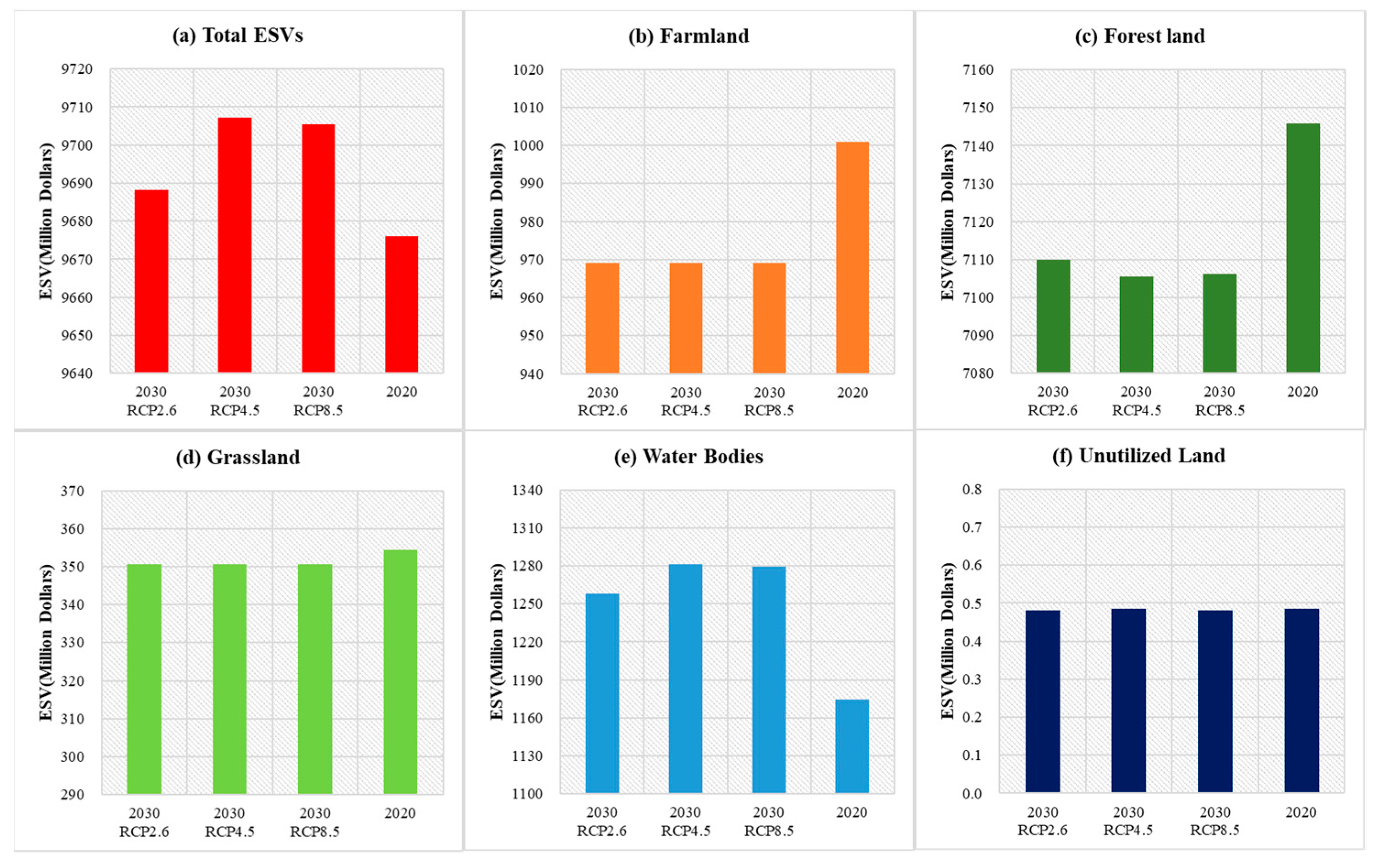
| Primary Classification | Secondary Classification | Farmland | Forestland | Grassland | Water Bodies | Unutilized Land |
|---|---|---|---|---|---|---|
| Provisioning services | Food supply | 299.8 | 109.3 | 77.6 | 282.1 | 0.0 |
| Raw material supply | 141.1 | 250.4 | 116.4 | 81.1 | 0.0 | |
| Water | 7.1 | 130.5 | 63.5 | 2923.6 | 0.0 | |
| Regulating services | Air quality regulation | 236.3 | 828.8 | 402.0 | 271.5 | 7.1 |
| Climate regulation | 127.0 | 2479.2 | 1065.0 | 807.6 | 0.0 | |
| Waste treatment | 35.3 | 701.8 | 352.7 | 1957.3 | 35.3 | |
| Regulation of water flows | 95.2 | 1237.8 | 779.4 | 36,056.0 | 10.6 | |
| Erosion prevention | 363.2 | 1008.6 | 490.2 | 328.0 | 7.1 | |
| Supporting services | Maintenance of soil | 42.3 | 77.6 | 38.8 | 24.7 | 0.0 |
| Fertility habitat services | 45.8 | 726.5 | 447.9 | 899.3 | 7.1 | |
| Cultural services | Aesthetic landscape provision | 21.2 | 402.0 | 197.5 | 666.5 | 3.5 |
| Primary Classification | Secondary Classification | 2000 | 2010 | 2020 |
|---|---|---|---|---|
| Provisioning services | Food supply | 341.4 | 332.2 | 324.7 |
| Raw material supply | 345.9 | 342.5 | 337.2 | |
| Water | 168.7 | 192.8 | 205.3 | |
| Regulating services | Air quality regulation | 967.9S | 965.8 | 954.5 |
| Climate regulation | 2433.5 | 2450.8 | 2432.6 | |
| Waste treatment | 717.0 | 735.8 | 738.7 | |
| Regulation of water flows | 1753.0 | 2047.0 | 2204.1 | |
| Erosion prevention | 1236.7 | 1231.0 | 1215.3 | |
| Supporting services | Maintenance of soil | 106.4 | 105.3 | 103.7 |
| Fertility habitat services | 741.5 | 751.3 | 748.5 | |
| Cultural services | Aesthetic landscape provision | 404.7 | 411.8 | 411.3 |
| Primary Classification | Secondary Classification | RCP2.6 | RCP4.5 | RCP8.5 |
|---|---|---|---|---|
| Provisioning services | Food supply | 317.9 | 318.0 | 318.0 |
| Raw material supply | 332.9 | 332.8 | 332.9 | |
| Water | 210.0 | 211.5 | 211.4 | |
| Regulating services | Air quality regulation | 945.6 | 945.3 | 945.3 |
| Climate regulation | 2419.1 | 2418.2 | 2418.3 | |
| Waste treatment | 738.1 | 738.8 | 738.7 | |
| Regulation of water flows | 2263.8 | 2282.2 | 2280.4 | |
| Erosion prevention | 1202.7 | 1202.3 | 1202.3 | |
| Supporting services | Maintenance of soil | 102.4 | 102.4 | 102.4 |
| Fertility habitat services | 745.5 | 745.5 | 745.6 | |
| Cultural services | Aesthetic landscape provision | 410.1 | 410.2 | 410.2 |
Publisher’s Note: MDPI stays neutral with regard to jurisdictional claims in published maps and institutional affiliations. |
© 2021 by the authors. Licensee MDPI, Basel, Switzerland. This article is an open access article distributed under the terms and conditions of the Creative Commons Attribution (CC BY) license (https://creativecommons.org/licenses/by/4.0/).
Share and Cite
Hou, J.; Qin, T.; Liu, S.; Wang, J.; Dong, B.; Yan, S.; Nie, H. Analysis and Prediction of Ecosystem Service Values Based on Land Use/Cover Change in the Yiluo River Basin. Sustainability 2021, 13, 6432. https://doi.org/10.3390/su13116432
Hou J, Qin T, Liu S, Wang J, Dong B, Yan S, Nie H. Analysis and Prediction of Ecosystem Service Values Based on Land Use/Cover Change in the Yiluo River Basin. Sustainability. 2021; 13(11):6432. https://doi.org/10.3390/su13116432
Chicago/Turabian StyleHou, Jun, Tianlin Qin, Shanshan Liu, Jianwei Wang, Biqiong Dong, Sheng Yan, and Hanjiang Nie. 2021. "Analysis and Prediction of Ecosystem Service Values Based on Land Use/Cover Change in the Yiluo River Basin" Sustainability 13, no. 11: 6432. https://doi.org/10.3390/su13116432
APA StyleHou, J., Qin, T., Liu, S., Wang, J., Dong, B., Yan, S., & Nie, H. (2021). Analysis and Prediction of Ecosystem Service Values Based on Land Use/Cover Change in the Yiluo River Basin. Sustainability, 13(11), 6432. https://doi.org/10.3390/su13116432






